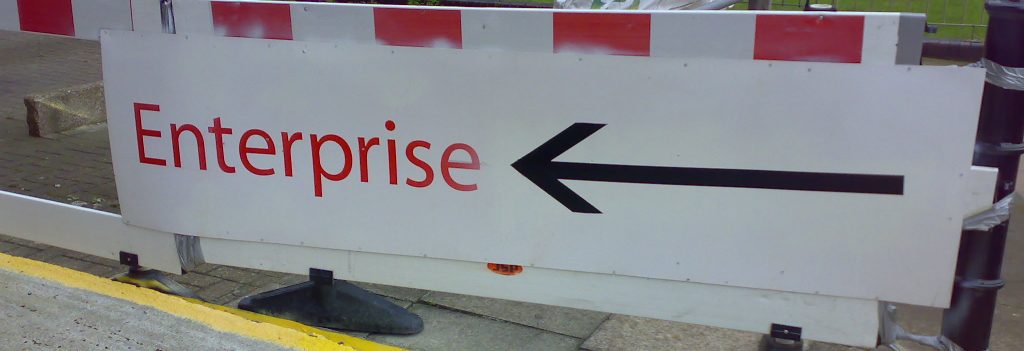Technological innovation won’t stop disrupting markets anytime soon. The need to innovate and modernize enterprise IT isn’t merely an option. If you’re doing things the way you did them five years ago, you’re closer to being disrupted than you know.
Enterprise IT is not a cost-center anymore. It’s a critical enabler of business success. Rapid innovation is the need of the hour for all enterprises, irrespective of their industry verticals. Every quarter spent without modernizing your enterprise IT is a quarter closer to being in battle with a leaner and smarter competitor who’s continually improving its IT capabilities.
The callout for sustainable innovation

It would appear that continual improvement is vital for modern enterprise IT. If it’s out in the market, and if it has spend-worthy use cases, it must be used. Is that the right approach to modernizing IT? Not quite.
The keyword to remember is this: sustainability. If that doesn’t ring any bells, think of sustainability as your license to freedom in the future.
In an era where enterprises are under unimaginable pressure to endorse the latest technologies, speed up application development life cycles, and position themselves as early adopters of technology, many of them are unknowingly binding themselves into unsustainable technology architectures. When today’s innovation comes at the cost of tomorrow’s freedom, there’s a problem for businesses.
What does this mean for key decision makers? They need to step up, look beyond the fact that they will not be in the same company five years down the line, and take IT decisions that don’t compromise the company’s ability to be agile tomorrow.
How can they do so? By understanding the four critical pillars of enterprise IT, and building the entire infrastructure so that the pillars remain strong.
Let’s understand each of these pillars.
1. Multicloud architecture
There’s been so much said and written about multicloud architecture that enterprises now know that they must adopt, even if they don’t understand the “why” behind it. Deploying your apps across multiple clouds to ensure high availability — that’s a narrow definition of multicloud strategy.
In reality, the true advantage of multicloud comes from giving developers the right services they require for app development. Though each cloud provider offers unique benefits, application developers require the utmost flexibility to be able to work in an unfettered manner.
Single cloud architecture poses technological limitations of all kinds. Multicloud, on the other hand, ensures that there are other cloud services available should any application development warrant the need for anything specific that’s not provided by the current vendors.
A well-managed multicloud architecture setup ensures that you retain the bargaining power when you talk about contract renewals and new contracts with your vendors. This helps your organization stay in control for the foreseeable future, and avoids situations of vendor lock-in.
The best of cost-effectiveness and service features — that’s how enterprises ensure flexibility and mobility in their IT infrastructure, and multicloud is the biggest enabler of this.
2. Virtualization
If you ask a modern enterprise about virtualization, they will probably make it sound like the Holy Grail of IT infrastructure. And that’s not far from the truth.
Virtualization offers countless benefits to businesses, from reducing their expenses to automating routine tasks and centralizing resource management. Moreover, virtualization enables employees to access their data anywhere, anytime on any device.
The concept of virtualization is rooted in savings. Virtualization allows organizations to cut down on IT expenses by requiring fewer resources like hardware servers. At the same time, they do not compromise on availability, computing performance, and scalability.
Virtualized servers help IT employees automate operations, thereby minimizing the operational expenses and lowering the ongoing management and administration of time-consuming, manual processes.
As firms reduce their server and hardware footprint, their energy consumption gets lowered along with datacenter square footage and cooling power.

Virtualization supports the maximum utilization of hardware and resources. With customer datacenter environments increasing in size and complexity, managing it can often prove difficult. Virtualization greatly limits such complexities by providing resource management capabilities that boost efficiencies in these virtual environments.
Numerous industries have fully embraced virtualization, putting the global storage market on course to enjoy a 24 percent annual growth rate from 2015 to 2019. So it would not be wrong to deem virtualization an indispensable aspect of modern enterprise IT.
3. Mobility
The work habits of the staff in modern enterprises has changed considerably, given how they enjoy access to various mobile devices and perform tasks on the move.
In fact, a recent Microsoft study found that one-out-of-three employees of companies using such enterprise mobility solutions depend on mobile-centric technologies to fulfill vital business activities. So, enterprises now require sustainable mobility to enhance customer responsiveness and boost the digital growth of businesses.
The rise of mobility in enterprises holds the potential to provide tangible business benefits by making information more accessible to the employees. Using the correct mobile platform allows organizations to improve their workforce productivity and streamline business activities, thereby achieving greater end-user convenience.
The strategic implementation of mobility within enterprises can have a transformative impact on workplace practices and organizational cultures. Businesses having a thorough understanding of the value of using enterprise mobility platforms are capable of creating and sustaining new competitive advantages and experiencing quicker business process improvements.
From real-time data analysis to greater operational efficiency, faster task allocation to increased productivity, the benefits of mobility are numerous. Thus, it is not surprising that modern enterprises would look to mobility as one of the driving forces of business growth.
4. Machine learning
Machine learning was overhyped for a while, but more often than not, it under-delivered. Now the hype is back once more and it can only be sustained if ML is made actionable. That’s why the operationalization of machine learning is now on the agenda of various enterprises.
Many of the same algorithms still exist but now greater amounts of data and improved computing power can be accessed at lower costs. So, the algorithms can be utilized more efficiently.

Enterprises must automate and take progressively intelligence actions via ML. Operational deployment in the enterprise happens when machine learning and predictive algorithms begin providing measurable outcomes and ROI.
Businesses need to invest more on an enterprise-grade framework so that all the parts – from machine learning to data – can have a transformative impact (kind of like the impact LeBron James and Chris Bosh had on the Miami Heat when they went there in 2010 and joined the amazing DWade!). For example, machine-learning algorithms automate and evaluate different processes that would otherwise require manual intervention, improving efficiency in the process and enabling you to execute continuously at scale.
Enterprise IT: Evolve, adapt, and innovate
These four pillars mentioned above, when combined together, offer IT organizations a comprehensive strategy to deliver applications rapidly while being adaptive enough to make future-specific changes.
Minus this level of flexibility, organizations may repeat mistakes from the legacy world, especially on the cloud. Only by embracing these four pillars of modern enterprise IT can companies benefit from newer technologies and retain the flexibility to evolve quickly in the future.
Featured image: Shutterstock



